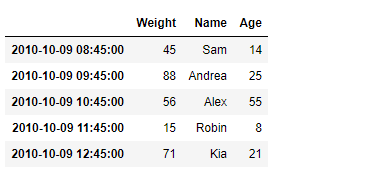Python| Pandas DataFrame.truncate
Pandas DataFrame 是一种二维大小可变的、潜在异构的表格数据结构,带有标记的轴(行和列)。算术运算在行标签和列标签上对齐。它可以被认为是 Series 对象的类 dict 容器。这是 Pandas 的主要数据结构。
Pandas DataFrame.truncate()函数用于在某个索引值之前和之后截断 Series 或 DataFrame。这是基于高于或低于某些阈值的索引值的布尔索引的有用简写。
Syntax: DataFrame.truncate(before=None, after=None, axis=None, copy=True)
Parameter :
before : Truncate all rows before this index value.
after : Truncate all rows after this index value.
axis : Axis to truncate. Truncates the index (rows) by default.
copy : Return a copy of the truncated section.
Returns : The truncated Series or DataFrame.
示例 #1:使用DataFrame.truncate()函数在给定数据帧的传递标签之前和之后截断一些条目。
# importing pandas as pd
import pandas as pd
# Creating the DataFrame
df = pd.DataFrame({'Weight':[45, 88, 56, 15, 71],
'Name':['Sam', 'Andrea', 'Alex', 'Robin', 'Kia'],
'Age':[14, 25, 55, 8, 21]})
# Create the index
index_ = pd.date_range('2010-10-09 08:45', periods = 5, freq ='H')
# Set the index
df.index = index_
# Print the DataFrame
print(df)
输出 :

现在我们将使用DataFrame.truncate()函数截断给定数据帧中“2010-10-09 09:45:00”之前和“2010-10-09 11:45:00”之后的条目。
# return the truncated dataframe
result = df.truncate(before = '2010-10-09 09:45:00', after = '2010-10-09 11:45:00')
# Print the result
print(result)
输出 :

正如我们在输出中看到的那样, DataFrame.truncate()函数已成功截断给定数据帧中传递标签之前和之后的条目。示例 #2:使用DataFrame.truncate()函数在给定数据帧的传递标签之前和之后截断一些条目。
# importing pandas as pd
import pandas as pd
# Creating the DataFrame
df = pd.DataFrame({"A":[12, 4, 5, None, 1],
"B":[7, 2, 54, 3, None],
"C":[20, 16, 11, 3, 8],
"D":[14, 3, None, 2, 6]})
# Create the index
index_ = ['Row_1', 'Row_2', 'Row_3', 'Row_4', 'Row_5']
# Set the index
df.index = index_
# Print the DataFrame
print(df)
输出 :

现在我们将使用DataFrame.truncate()函数截断给定数据帧中“Row_3”之前和“Row_4”之后的条目。
# return the truncated dataframe
result = df.truncate(before = 'Row_3', after = 'Row_4')
# Print the result
print(result)
输出 :

正如我们在输出中看到的那样, DataFrame.truncate()函数已成功截断给定数据帧中传递标签之前和之后的条目。